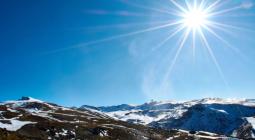Meteorologists could be climate change heroes by relaying its urgency to the public
Weathercasters are positioned to help viewers connect short-term extreme events – like hurricanes – with the climate crisis
Some have called Hurricanes Helene and Milton an October surprise. Yet such disasters are now dispiritingly predictable. In their wake, pundits have asked whether and how the storms – which happened to hit some key swing states – could impact a presidential election shaping up to be decided by razor-thin margins.
There’s practical concerns, like whether some affected voters will physically be able to cast their ballots. And then there’s a political question: Will the fact that the climate crisis, which is exacerbated these hurricanes, raise the importance of that issue? Or will that be counterbalanced by those who have become convinced the government engineered these disasters to suppress electoral power?
Believe it or not, the answer could rest on the shoulders of your local weather reporter.
Such an unlikely hero went viral earlier this month when John Morales, a venerable meteorologist in Miami, became visibly emotional on air during one of his reports on Milton. His voice choking, he offered an ominous assessment of the hurricane’s strength: “This is just horrific.” That sincerity and urgency garnered the clip nearly 2m views. The resonance of Morales’s appearance proves that combining deep expertise, hard-earned credibility and a willingness to be vulnerable could provide a roadmap – or a forecast – for climate reporting to remain relevant and impactful despite the headwinds.
Climate change presents the classic political conundrum of a (literally) glacial catastrophe demanding swift action. To avert the worst effects, the investments required – from clean energy to flood-proof infrastructure – would total in the trillions, but voters tend to be wary of making such outlays until the worst has already happened. Polling bears out this “short-termism.” Americans have gone from climate skeptics to climate curious, with 54% saying they consider it a major threat. And yet when it comes time to rank their top issues heading into election day, the public demurs, placing climate change second to last on their list of priorities. Of course, the repeat champion remains the economy – never mind that with smart policies, combating the climate crisis could be a lifesaver and a job creator.
Despite the popular narrative, global heating does have short-term consequences, namely extreme weather events like Hurricanes Helene and Milton. Over the past three decades, extreme weather has caused $48bn in crop damage, $339bn in property damage and killed nearly 14,000 people. And the intensity of that damage has been exacerbated by rising temperatures.
Amid these catastrophes, reeling residents turn to local news broadcasts for live updates, with ratings sometimes spiking by 80% during hurricanes. In such moments, meteorologists are perfectly positioned to help viewers connect short-term extreme weather with long-term climate change – having forged a deep connection with a wide audience all year round.
Republicans and Democrats alike rank the Weather Channel as their most trusted news source. And meteorologists remain among the most trusted sources regarding global heating in communities nationwide, even though trust in the media generally continues to plummet.
To be sure, weathercasters haven’t been completely unscathed by today’s hyper-fragmented, ultra-polarized media landscape; they, along with Fema workers, have had to endure harassment and death threats directly tied to inflammatory disinformation. But such encounters, while serious, remain exceptional. Local meteorologists are still the most effective and credible mass communicators we have – better positioned than almost anyone to persuade on climate, if armed with the right message.
Enter Climate Central, a nonprofit which creates weekly climate content for meteorologists and weather reporters tailored to their specific communities. The organization empowers local journalists to make climate change personal, equipping partners in 95% of American media markets with the science, big data and targeted graphics they need to help audiences understand what’s happening in their own backyards – and, critically, what can be done about it.
Covering Climate Now has taken this approach globally. Co-founded by the Nation, the Guardian and the Columbia Journalism Review, CCN provides local journalists worldwide with climate reporting resources, from training to targeted investigations of issues like extreme drought or big oil. The journalists they support have a collective audience of 2 billion people in 60 countries. But the basic strategy remains the same no matter the continent, as described in a recent column in the Nation by CCN co-founder Mark Hertsgaard: “Weathercasters talk their viewers through scary times by calmly providing practical, life-saving information.” If you want proof of its efficacy, look no further than John Morales, a longtime CCN colleague.
These efforts bring the media closer to treating climate change like it does every other issue, providing macro context for micro events in the simplest terms possible. The Dow Jones industrial average offers readers a digestible daily snapshot of the American stock market. Its ticker tape runs endlessly on CNBC and in Times Square. Why not cover extreme weather with the same unswerving attention? At the very least, why not dedicate 30 seconds of every evening newscast to the latest movement on the US climate extremes index?
If we want to curb climate change’s effect on our planet, it might just start with weather reporters bringing the issue down to earth.
Cover photo: By The Guardian




